Greetings, ambitious project managers and aspiring team leaders! In the ever-evolving landscape of modern business, the pursuit of success demands not only vision but also a dynamic approach to project execution. It is in this realm that the concept of cross-functional teams shines as a beacon of collaboration, innovation, and collective excellence.
Imagine a team where diverse talents converge, each member bringing their unique expertise to the table, united by a common goal. Cross-functional teams epitomize the essence of synergy, where the whole becomes greater than the sum of its parts.
In this article, we invite you to dive into the world of cross-functional teams in project management – a world that thrives on the amalgamation of ideas, perspectives, and skills from individuals across various disciplines.
What Is a Cross-Functional Team?
A cross-functional team is a group of individuals with diverse expertise, skills, and knowledge, brought together to work on a specific project or task within an organization. Unlike traditional teams that consist of members from a single department or function, cross-functional teams are composed of individuals from various departments or functional areas.
The primary objective of forming cross-functional teams is to leverage the collective strengths of team members from different backgrounds, fostering collaboration and enabling a holistic approach to problem-solving and decision-making.
Cross-functional teams have become increasingly prevalent in modern organizations due to their ability to drive innovation, streamline processes, and respond more effectively to dynamic market demands.
By breaking down silos between departments and encouraging open collaboration, these teams create a fertile ground for creativity and efficiency, leading to better outcomes and enhanced organizational performance.
Why Is Creating a Cross Functional Team So Important? – Benefits of Cross-Functional Work
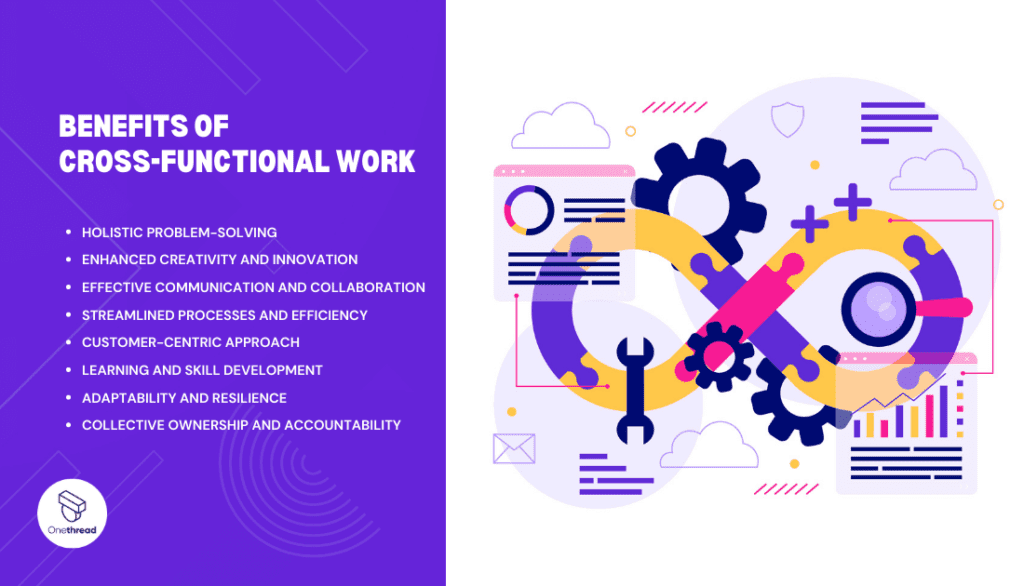
Creating a cross-functional team is of paramount importance in today’s business landscape for several compelling reasons. As an organizational leader or project manager, understanding the significance of cross-functional teams can be a game-changer in driving success and fostering a culture of innovation within your company.
Here are the key reasons why forming cross-functional teams is essential in your worklife:
Holistic Problem-Solving
Cross-functional teams bring together individuals with diverse backgrounds and skillsets. This diversity of expertise allows the team to approach problems from multiple angles, leading to more comprehensive and effective solutions. By incorporating different perspectives, these teams can identify blind spots, consider various possibilities, and make better-informed decisions.
Enhanced Creativity and Innovation
When team members with different experiences collaborate, it sparks a creative synergy that fuels innovation.
By encouraging the exchange of ideas and knowledge from various disciplines, cross-functional teams can generate groundbreaking solutions and explore uncharted territories that a single-discipline team might overlook.
Effective Communication and Collaboration
In traditional hierarchical structures, communication barriers between departments can hinder progress. Cross-functional teams break down these barriers, fostering open communication channels and promoting a culture of collaboration.
This facilitates smoother coordination, reduces misunderstandings, and ensures that all team members are aligned with the project’s objectives.
Streamlined Processes and Efficiency
Cross-functional teams streamline processes by optimizing the use of available resources. Each team member contributes their specialized skills, eliminating redundancies and accelerating project timelines.
This streamlined approach not only saves time but also enhances overall efficiency and productivity.
Customer-Centric Approach
By bringing together representatives from different functions, cross-functional teams can better understand and address the diverse needs of customers. This customer-centric approach leads to the development of products and services that resonate with target audiences and result in higher customer satisfaction.
Learning and Skill Development
Working in a cross-functional team exposes individuals to new perspectives and challenges, promoting continuous learning and skill development. Team members can expand their knowledge beyond their domain and gain valuable insights from their colleagues’ expertise.
Adaptability and Resilience
In a fast-paced and ever-changing business environment, cross-functional teams excel in adapting to new circumstances and challenges. Their diverse skillsets and collective problem-solving capabilities empower them to navigate uncertainties and pivot when required, making them an invaluable asset in volatile markets.
Collective Ownership and Accountability
Cross-functional teams share a sense of ownership and accountability for the project’s success. Because each member contributes their unique skills, successes are celebrated as team achievements, fostering a strong sense of camaraderie and motivation.
Types of Cross-Functional Collaboration
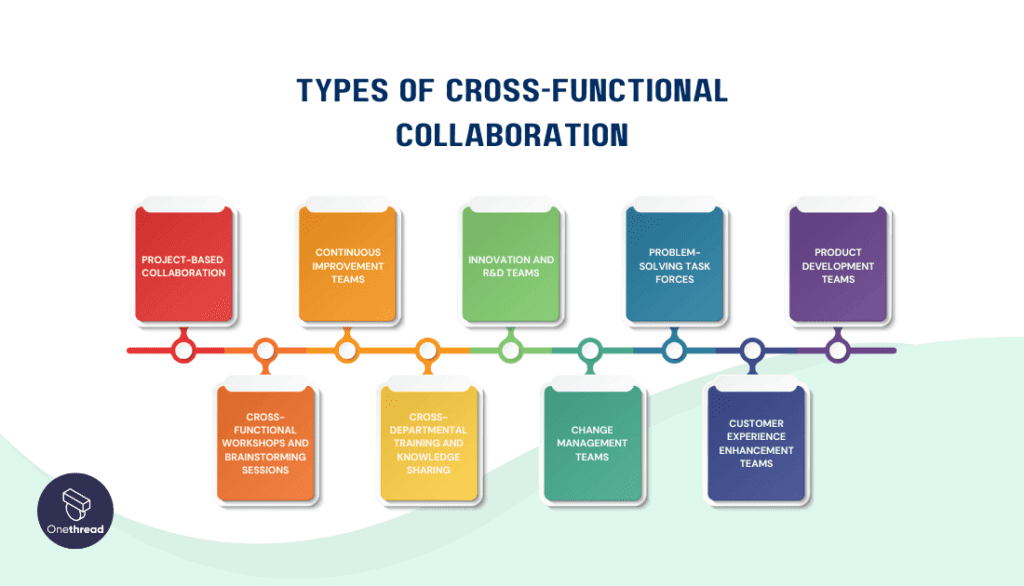



Cross-functional team collaboration can take various forms, each tailored to the specific needs and objectives of the project or organization. Here are some common types of cross-functional team collaboration:
Project-Based Collaboration
In this type of collaboration, cross-functional teams are formed to work on a specific project or initiative. Each team member contributes their expertise to accomplish project goals, and the team disbands once the project is completed. Project-based collaboration is particularly useful for tackling complex and time-bound tasks, leveraging the collective strengths of team members from different departments.
Continuous Improvement Teams
These cross-functional teams focus on identifying areas for improvement within the organization’s processes, products, or services. The team members collaborate to analyze data, gather insights, and implement changes to enhance efficiency and quality continually.
Continuous improvement teams promote a culture of innovation and learning within the organization.
Innovation and R&D Teams
Innovation-focused cross-functional teams are tasked with generating new ideas, developing innovative products, or exploring emerging technologies.
By bringing together experts from diverse disciplines, these teams encourage creative thinking and develop groundbreaking solutions that drive the organization’s competitiveness.
Problem-Solving Task Forces
When critical challenges or crises arise, organizations often form cross-functional task forces to address the issues promptly. These teams work collectively to analyze the problem, devise strategies, and implement solutions to mitigate the impact and prevent future occurrences.
Product Development Teams
In product development, cross-functional collaboration is vital to creating successful products that meet customer needs. These teams typically include representatives from design, engineering, marketing, and other relevant departments to ensure that the final product aligns with market demands and is technologically feasible.
Cross-Functional Workshops and Brainstorming Sessions
Workshops and brainstorming sessions involving members from different departments enable the exchange of ideas and perspectives. These collaborative sessions foster creativity and help solve specific challenges or generate innovative solutions collectively.
Cross-Departmental Training and Knowledge Sharing
Cross-functional collaboration can also involve training sessions or knowledge-sharing initiatives. This type of collaboration encourages the sharing of best practices, expertise, and insights across departments, leading to a more informed and skilled workforce.
Change Management Teams
During periods of organizational change or transformation, cross-functional teams play a crucial role in managing the transition. These teams assess the impact of change, communicate effectively with all stakeholders, and implement strategies to facilitate a smooth transformation process.
Customer Experience Enhancement Teams
To improve the customer experience, cross-functional teams analyze customer feedback and journey data. They collaborate to implement improvements across different touchpoints and ensure that the organization delivers exceptional customer service.
How to Build a Cross Functional Team? 14 Steps to Make Your Own Functional Teams
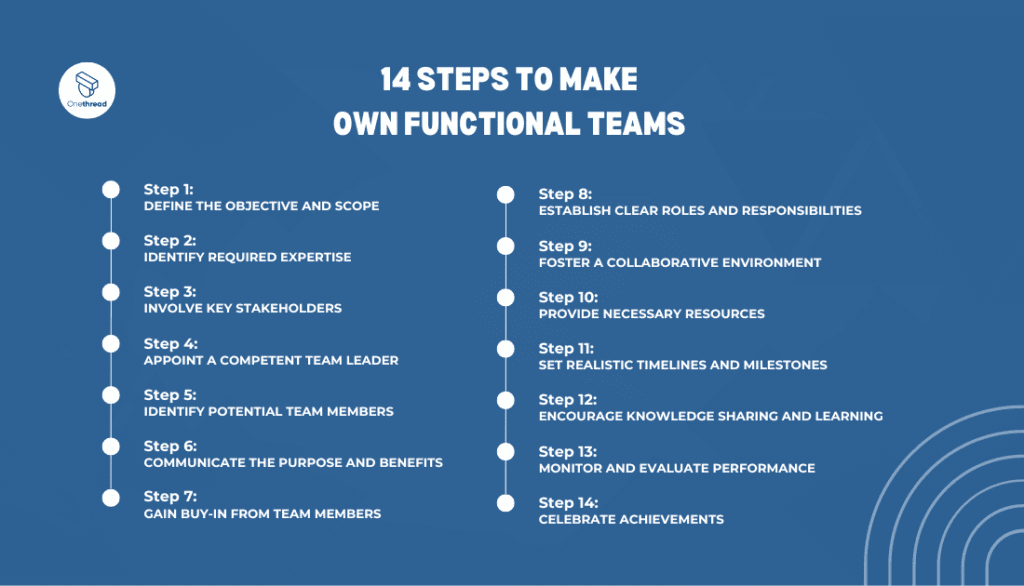



Building a successful cross-functional team requires careful planning, thoughtful selection of team members, and effective leadership. Here is a step-by-step guide to building a cross-functional team:
Step 1: Define the Objective and Scope
Clearly outline the project’s objective and scope for which the cross-functional team is needed. Ensure that the project’s goals align with the organization’s overall mission and strategy.
Step 2: Identify Required Expertise
Identify the specific skills, expertise, and knowledge required to achieve the project’s objectives. Determine which departments or functional areas must be represented in the team to cover all essential aspects of the project.
Step 3: Involve Key Stakeholders
Engage key stakeholders, including department heads and team leaders, in the formation of the cross-functional team. Secure their support and commitment to collaborate in achieving the project’s goals.
Step 4: Appoint a Competent Team Leader
Select a competent and experienced team leader who can effectively manage the cross-functional team. The leader should possess strong communication, conflict resolution, and decision-making skills.
Step 5: Identify Potential Team Members
Identify potential team members from different departments who possess the required expertise and are open to collaboration. Consider their track record of teamwork, adaptability, and willingness to contribute to the project’s success.
Step 6: Communicate the Purpose and Benefits
Clearly communicate the purpose of the cross-functional team to all potential members. Emphasize the benefits of collaboration, innovation, and the potential impact of the project on the organization’s success.
Step 7: Gain Buy-In from Team Members
Seek buy-in from potential team members by involving them in the decision-making process. Address their concerns and demonstrate how their involvement will be valued and recognized.
Step 8: Establish Clear Roles and Responsibilities
Define the roles and responsibilities of each team member, outlining their specific contributions to the project. Ensure that everyone understands their unique role and the significance of their contribution.
Step 9: Foster a Collaborative Environment
Encourage a culture of open communication, trust, and mutual respect within the team. Establish regular meetings and channels for sharing ideas, progress updates, and feedback.
Step 10: Provide Necessary Resources
Ensure that the cross-functional team has access to the resources they need to execute the project effectively. This may include budgetary support, equipment, or support from other departments.
Step 11: Set Realistic Timelines and Milestones
Define realistic timelines and milestones for the project. Regularly review progress and make adjustments as necessary to stay on track.
Step 12: Encourage Knowledge Sharing and Learning
Promote knowledge sharing and learning opportunities within the team. This can be through workshops, training sessions, or informal knowledge-sharing activities.
Step 13: Monitor and Evaluate Performance
Regularly monitor the team’s performance and evaluate their progress towards achieving the project’s objectives. Provide constructive feedback and recognize team members’ contributions.
Step 14: Celebrate Achievements
Celebrate the team’s achievements and successes, both big and small. Acknowledge individual efforts and the collective impact of the cross-functional team.
Challenges of Maintaining Cross-Functional Teams
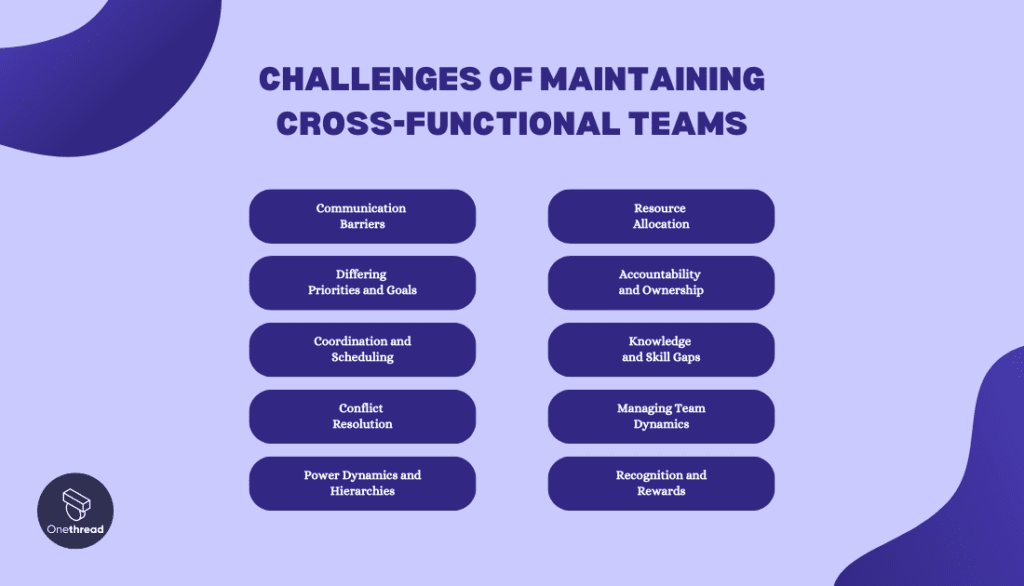



While functional teams offer numerous benefits, they also present certain challenges that must be addressed to ensure their sustained effectiveness. Managing and maintaining a successful cross functional team requires proactive measures and a commitment to overcoming these obstacles.
Here are some of the key challenges faced when maintaining a cross-functional team:
Communication Barriers
Different departments often have their own jargon, processes, and communication styles, leading to potential misunderstandings and misinterpretations within the team. Effective communication becomes crucial to bridge these gaps and ensure that all team members understand each other clearly while working cross-functionally.
Differing Priorities and Goals
Team members from various functions may have conflicting priorities or objectives, potentially leading to disagreements over resource allocation and project focus during a cross-functional work project. Aligning the functional team towards a common goal and ensuring everyone’s objectives are acknowledged can be a delicate balancing act.
Coordination and Scheduling
Coordinating team members from different departments, who may have varying work schedules and commitments, can be challenging. This could lead to delays in decision-making or project execution, necessitating efficient scheduling and clear timelines.
Conflict Resolution
With diverse perspectives comes the potential for conflicts to arise. Resolving conflicts promptly and constructively is vital to maintain team cohesion and functional collaboration while preventing detrimental impacts on the project’s progress.
Power Dynamics and Hierarchies
In cross-functional teams, individuals may carry different levels of authority and influence within their respective departments. Balancing these power dynamics and ensuring that all team members’ opinions are valued can be critical to fostering a collaborative environment.
Resource Allocation
Cross-functional teams often require resources from various departments, and obtaining these resources can be challenging if priorities clash or if there is a lack of support from higher management.
Accountability and Ownership
Clearly defining roles and responsibilities within the team is essential. Without a sense of individual ownership and accountability, team members may feel less motivated to contribute their best efforts.
Knowledge and Skill Gaps
Not all team members may possess a comprehensive understanding of each other’s areas of expertise, leading to potential gaps in knowledge. Encouraging knowledge-sharing sessions and training opportunities can help mitigate this challenge.
Managing Team Dynamics
The diverse composition of cross-functional teams means that team dynamics can be complex. Effective leadership and team-building efforts are necessary to create a cohesive and collaborative group.
Recognition and Rewards
Recognizing and rewarding the achievements of cross-functional teams can be challenging due to the collective nature of their work. Implementing fair and inclusive reward systems that acknowledge individual and team contributions is crucial to maintaining team motivation.
Streamlining Cross-Functional Team Synergy with Onethread
In the dynamic landscape of modern business, cross-functional teams have become the backbone of successful projects. However, coordinating efforts across different departments with diverse skill sets, perspectives, and timelines can be a formidable challenge.
Enter Onethread, a multifaceted tool designed to transform the way cross-functional teams collaborate, manage projects, track time, and organize information.
Unified Project Management
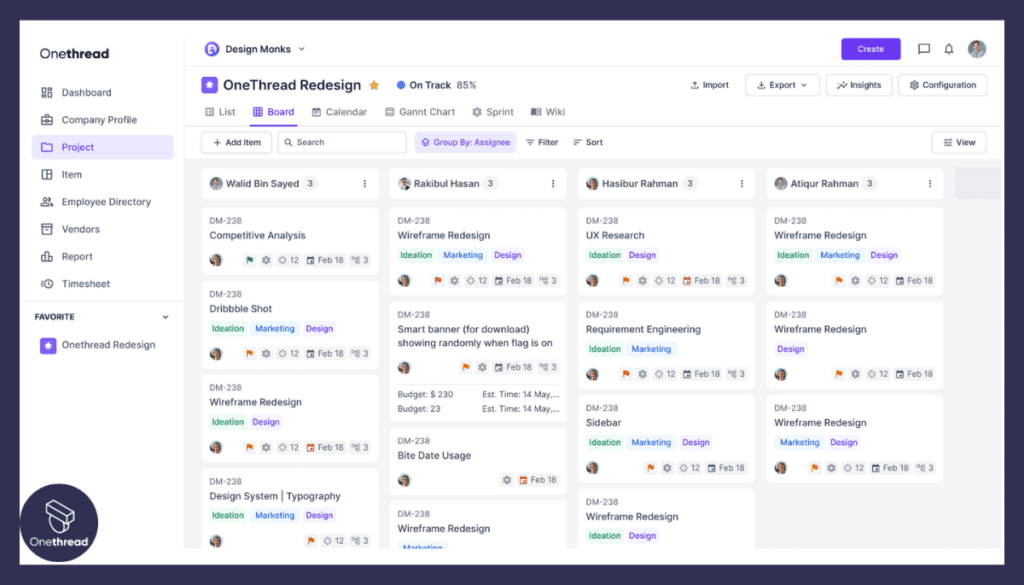



Onethread serves as a central hub where cross-functional teams can collaboratively manage projects from inception to completion. The platform provides intuitive project planning tools, task assignment, and milestone tracking, ensuring that everyone is aligned towards common goals.
With shared project timelines and progress updates, every team member gains a clear understanding of the project’s status and their role within it.
Seamless Communication
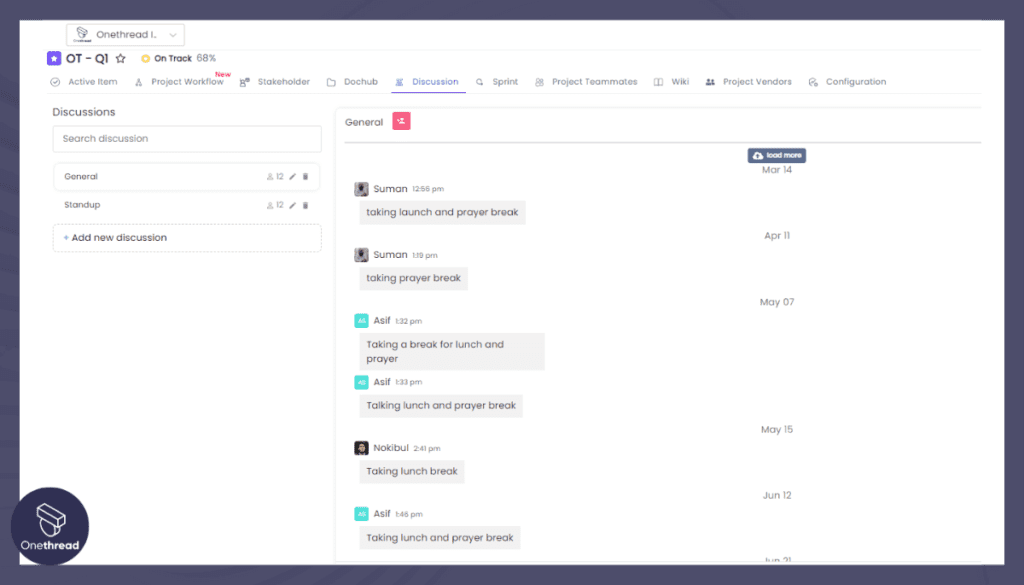



Effective communication is vital for cross-functional teams, and Onethread excels in facilitating transparent interactions. Its real-time messaging and comment features allow team members to discuss tasks, share ideas, and ask questions directly within the project context.
This eliminates the need for lengthy email chains and ensures that important conversations are readily accessible to everyone involved.
Time Tracking and Resource Management
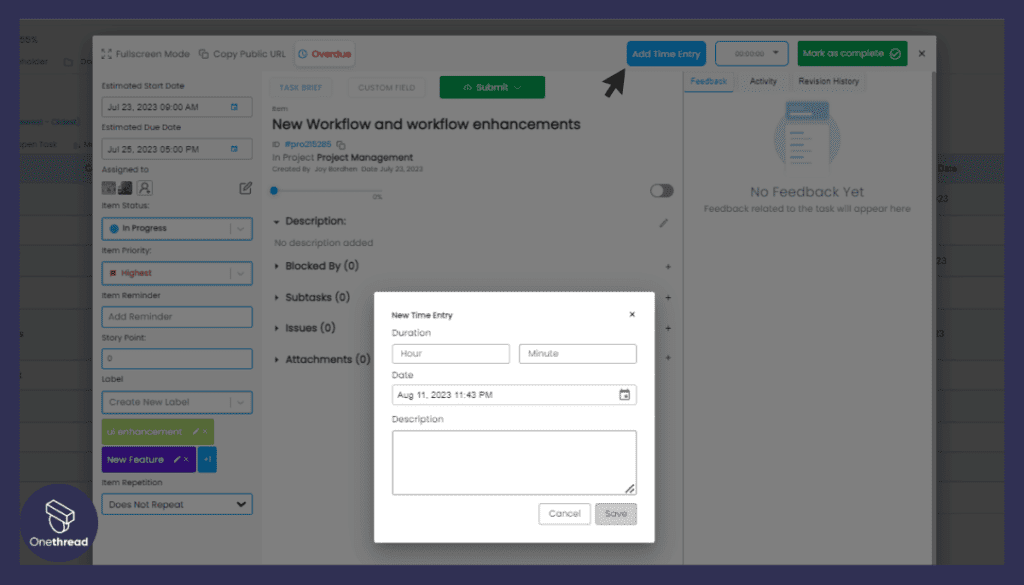



Onethread simplifies time tracking by enabling team members to log their work hours directly within the platform. This not only aids in project billing and resource allocation but also provides insights into individual and team productivity.
With a comprehensive overview of time spent on various tasks, managers can optimize resource distribution and ensure efficient work allocation.
Collaborative Note-Taking
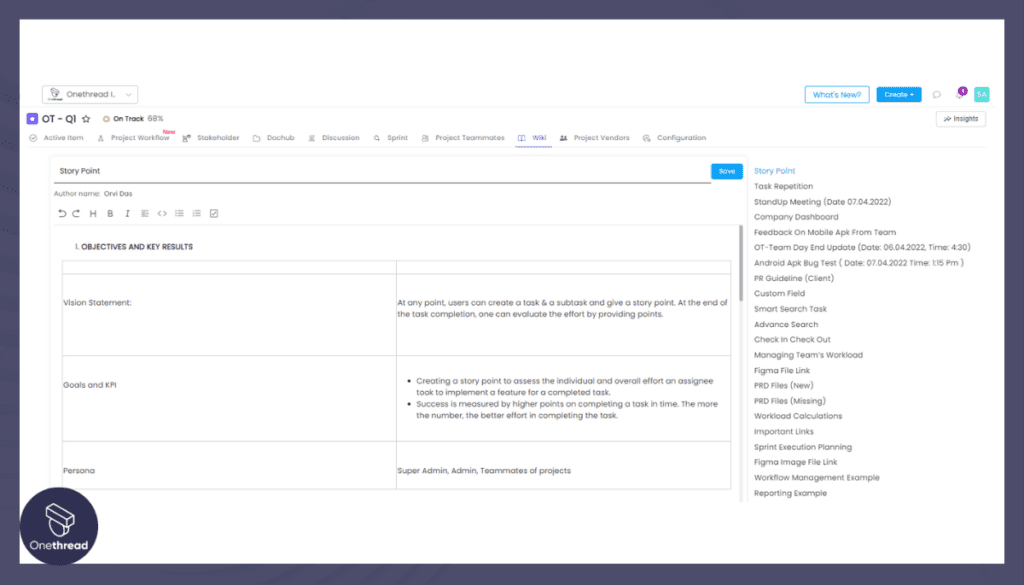



Cross-functional teams often generate a wealth of information during their collaborations. Onethread’s note-taking capabilities allow team members to record meeting minutes, brainstorming sessions, and important insights within the context of the project.
This shared repository of knowledge ensures that critical information isn’t lost and can be easily accessed by all team members.
Enhanced Accountability
With roles, responsibilities, and deadlines clearly defined within Onethread, cross-functional teams benefit from increased accountability. Team members can view their tasks, deadlines, and project dependencies, fostering a sense of ownership and encouraging timely completion of assignments.
Data-Driven Insights
Onethread’s reporting and analytics tools provide cross-functional teams with data-driven insights into project performance, team productivity, and resource utilization. These insights empower team leads and managers to make informed decisions, identify bottlenecks, and continuously improve collaboration processes.
Parting Words
The advent of cross-functional teams has undoubtedly revolutionized the landscape of project management, providing organizations with a powerful tool to drive success and innovation.
By breaking down silos and bringing together individuals from different disciplines and perspectives, these teams create an environment where collaboration, creativity, and collective ownership thrive.
As you venture forward in your project management endeavors, consider embracing the cross-functional approach, recognizing the immense potential it holds for fostering efficiency, driving progress, and ultimately achieving remarkable results.
Embrace the power of diversity and collaboration, and witness the transformational impact of cross-functional teams on your organization’s projects. Here’s to embracing new possibilities and embracing the spirit of innovation in all your future project undertakings!
